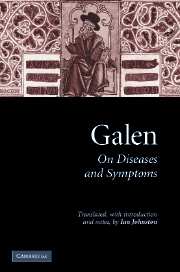Book contents
- Frontmatter
- Contents
- List of tables
- Acknowledgements
- List of abbreviations
- PART I INTRODUCTION
- I.1 General introduction
- I.2 Galen's life and works
- I.3 Galen's philosophical and medical antecedents
- I.4 Definitions and terminology
- I.5 The classification of diseases and symptoms
- I.6 Causation in diseases and symptoms
- PART II TRANSLATION
- PART III CONCLUSION
- Bibliography
- Index
I.5 - The classification of diseases and symptoms
Published online by Cambridge University Press: 22 September 2009
- Frontmatter
- Contents
- List of tables
- Acknowledgements
- List of abbreviations
- PART I INTRODUCTION
- I.1 General introduction
- I.2 Galen's life and works
- I.3 Galen's philosophical and medical antecedents
- I.4 Definitions and terminology
- I.5 The classification of diseases and symptoms
- I.6 Causation in diseases and symptoms
- PART II TRANSLATION
- PART III CONCLUSION
- Bibliography
- Index
Summary
INTRODUCTION
In the four translated treatises, two on diseases and two on symptoms, the first of each pair is devoted to definition and classification. In any nosological endeavour, classification depends on definition. Here the entities (if, in fact, they are entities) to be defined (if, in fact, definition is applicable) are disease and symptom. The two provisos, obviously interrelated, are intended to indicate the difficulties of Galen's taxonomic undertaking, difficulties which he himself clearly acknowledged, not least when he considered the issue of ‘disease in itself’. It is undeniable, however, that a satisfactory classification of, and distinction between, diseases and symptoms is of considerable value in both the theoretical and the practical aspects of medicine. Prior to these treatises there is no attempt at systematic and exhaustive classification, at least none that is extant, which invests these works with particular historical interest, not to mention their relevance to medical practice at the time. As has been noted earlier, Galen himself saw them as a necessary bridge between his theoretical writings and his manuals of practical medicine.
This is not to say there were not some prior attempts at definition and classification – there were – but what is notable is their paucity both in number and content. This is especially surprising given the attention paid to these matters in other fields, including biology generally, by such notables as Aristotle, Speusippus and Theophrastus.
- Type
- Chapter
- Information
- Galen: On Diseases and Symptoms , pp. 65 - 80Publisher: Cambridge University PressPrint publication year: 2006



